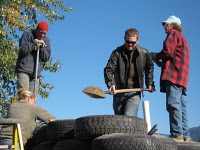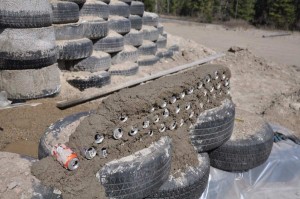
We started our first pop can wall today. We decided to make the bond beam form on the front wall out of pop cans, a traditional method according to Michael Reynolds.
We opted for cans because the front wall will be most susceptible to moisture, both from the dirt that will be backfilled to this wall, and from rain and snow that will slide down our slanted windows.
The Eartship books call for a mixture of one part cement and three parts sand. Because we were working in smaller amounts and having to make a matrix of concrete and metal cans, we decided to screen the sand a second time. Chris built a screen out of 2×6 and leftover stucco wire, which left the resulting sand very find indeed. We didn’t take picture of this, but by looking at the wall, I see more screening in our future!
Our first dilemma was making a line down the tires that was parrallel to our closest rafter position. After arguing discussing this problem we decided to run a string line from one end of the building to the other at rafter height, took our 12′ level and made a perpendicular line. We measured from the level to the tires at many positions and ran a chalk line, marking the line in lumber crayon on the tires, since the chalk line was inadequate for marking.
We used this chalk line to line up the bottom ends of the pop cans which will be inside the bondbeam. We positioned the can tabs alternating directions as indicated in the Earthship volumes. This alternation makes plastering (using the tabs as lath) much easier down the road.
It became apparent very quickly that a) pop can contruction is an art not a science and b) while easier physically than tire packing, this job was going to take us all weekend…
But here it is…looks just like in all the pictures!
